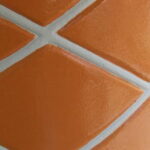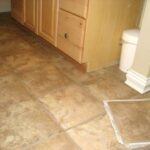Resilient Tile Flooring
Do you have a commercial or residential floor area that you’d like to cover inexpensively? If so, then you may be a candidate for a new type of vinyl resilient floor tile. This tile is very similar to the traditional square floor tiles of the past, but gives the updated look of a ceramic tile application of today. This new vinyl resilient floor tile can be installed with or without grout.
When installed with grout, the tile takes on the authentic look of ceramic tile flooring.
The individual squares of tile are made to mimic the more costly ceramic tile, particularly when installed with the grout. Grouting the tile gives the individual square tiles more durability and protection against lifting, peeling and shifting. Grouting also provides the tile added protection from water penetration, a huge factor in prolonging the life of the floor.
I had a small bathroom that desperately needed new flooring. The bathroom had the old 12×12 inch self-stick square floor tiles with a dated pattern on it. I figured the bathroom could be easily updated by adding new flooring. I didn’t want to go the ceramic tile route because of cost. I also knew that by installing the vinyl resilient tile flooring, I could easily change the flooring material at a later date.
To begin the project, I purchased one box of tiles in the color of my choice. The Home Depot sells a brand called Traffic Master. That is the brand that I’ll be referencing in this article. Tools needed: chalk line string, carpenter’s square, utility knife, pencil, plain white paper for tracing templates. For making straight, accurate cuts of the tile, and to ensure the entire job went smoother, I rented a tile cutter at the Home Depot for around $25.00. If you choose to install your tile with grout lines, you will also need: spacers in the appropriate width, grout float, sponge, bucket of water and towels.
To remove the old flooring, I simply lifted the old square tiles by the corner using a metal scraper. Since the tiles were very old, and water damaged, they popped right up. If your tile gives you problems, there are tools and solutions at your local home supply store. Once you have removed the old flooring and have thoroughly cleaned and properly prepared the sub floor you are ready to lay the new tile. Note: It is extremely important that the sub floor be thoroughly clean and level before attempting to install the new tile flooring.
Prior to beginning to lay the tile, identify the predominant area of the room as one big rectangle. Do not worry about any smaller, irregular shaped areas off from the rectangle. I will explain those areas later. Snap a lengthwise chalk line down the middle of the longest part of the rectangle. I am referring to the two end walls that are the furthest distance apart from each other. Find the middle and snap a chalk line. Next, find the midpoint of the chalk line that you’ve just made. Draw a midpoint line extending six inches above and below the chalk line. Now lay the carpenter square’s vertical side (the part that is extending up and down) or one of the new square tiles’ vertical line directly along the midpoint line. At this point, the carpenter’s square or square tile should also be sitting directly on top of the chalk line. Using the vertical edge of either the carpenter’s square or the square tile as a guide, extend the midpoint line all the way up and down, meeting the other two remaining walls (the walls that are the shortest distance away from each other). The rectangle should now be divided into four equal parts.
To begin laying the tile, lay one of the square tiles at any corner where the long center line and midpoint corner meet. From that point, you can start placing other square tiles on the floor to determine the floor pattern. Fill in the rectangle first, then move beyond the area of the rectangle. When you get to irregular shaped areas you will need to make a template. To do this, simply get a sheet of white paper and press it down firmly outlining the irregular shape. Trace the shape onto the paper. Cut the shape out that has been traced. Place, tape or glue the template onto the top of one of the square tiles. To cut the square tiles, use a utility knife or scissors. Cut or score the tile along the outline of the template. I found it helpful to lay the tile on a carpeted floor to make small scores in the tile until the tile was cut into the shape of the template. Once you have arranged the tile, and any irregular cut pieces of tile on the floor, carefully peel and remove the backing sheets. Be careful when peeling the backing sheets off as they are very sticky. Begin laying the tile down one by one. Guide off the very first tile that was placed in the corner of the long center line and midpoint. For accuracy, it may help to use a pencil to trace the outline of exactly where the tile should be positioned.
This particular tile is made to resemble a ceramic tile floor complete with grout lines. To get the look, use tile spacers in the desired size. I encountered one problem while using this tile. Since the square tiles are not the depth of standard ceramic tile, it was difficult for the spacers to be held in place, as they typically do with regular ceramic tile. I ended up having to leave measured spaces between the tiles when laying them to allow for the grout lines.
Mix the grout according to the directions. Add enough water until the grout mix resembles cake batter. It should not be too stiff or too runny. Pour the grout into the grout lines. Allow the grout to set for 10 minutes. Using a sponge and a bucket of water, dip the sponge into the water. Wring the water out of the sponge. Use the damp sponge to remove the excess grout off the floor. Wipe and dry any residue off the tile with an old towel or wash cloth. DO NOT attempt to grout and clean the entire floor at once. The excess grout will cure and dry onto the floor tiles long before you will ever have a chance to properly clean all of the tiles. Instead, work in small 24X24″ sections (approximately 4 tiles) at a time.
To keep the floor and grout protected over time, use a quality tile floor sealant. Prior to sealing, let the grout cure for at least 72 hours. After that time, sweep and clean the floor thoroughly. Pour the stain into a standard lined paint tray. Remember to keep the stain filled tray behind you at all times, while continuing to work your way out of the room. Using a small brush, apply the stain in corners and hard to reach places first. Finish by applying the stain over the entire floor using a clean, low nap paint sleeve and extension arm roller. Use long, even strokes as you move the paint roller from left to right across the entire floor. Remember: you are working your way out of the room. Leave the tray with the stain behind you, as you work your way out of the room. Turn any lights off as you go. Once you have completely stained the floor, let it dry untouched for at least 24 hours. Try to eliminate any drafts from entering the sealed floor area while it dries. Periodically, you may re-seal the floor as necessary. Follow a regular cleaning schedule with a quality cleaning product that is both non-abrasive and does not leave a residue.
The resilient tile floor is a relatively inexpensive option in comparison to standard ceramic tile flooring. Resilient tile offers an attractive flooring option, complete with strength, durability and the choice of a seamless or grouted tile floor covering. Resilient tile flooring is also far easier to remove than ceramic tile, should you ever need or want to replace your floor in the future. If installed and cared for properly, this type of flooring should serve you well over time.




